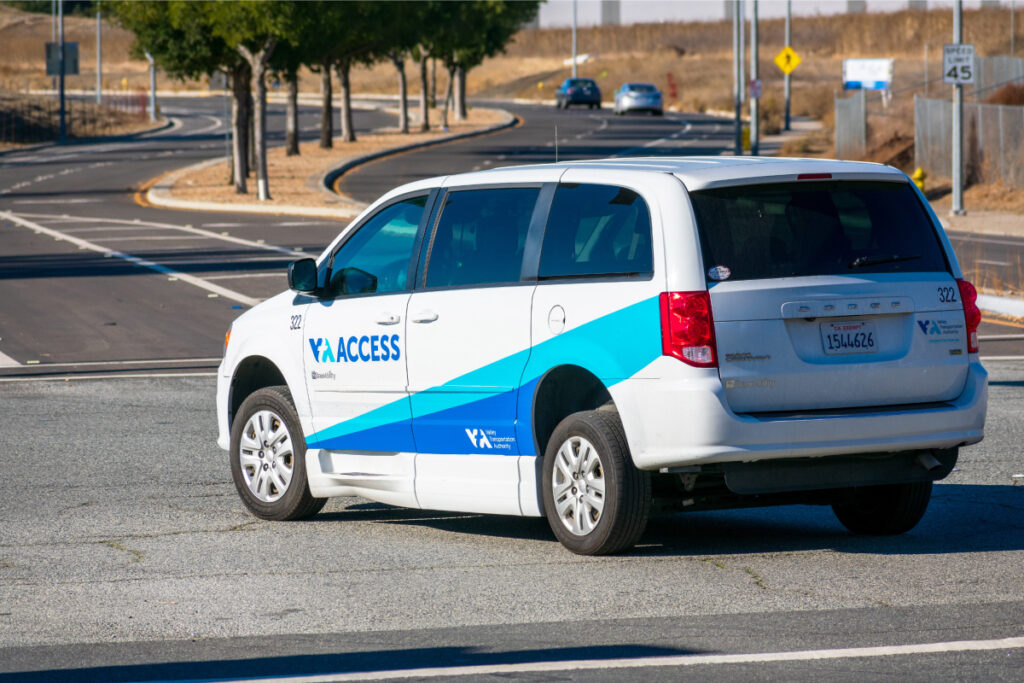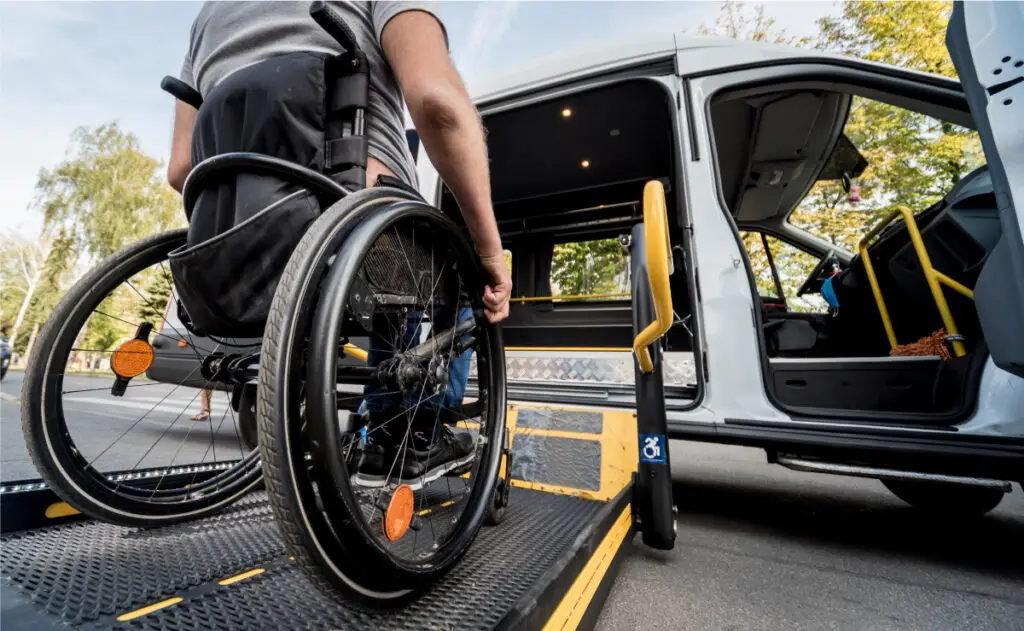February 26, 2024

Paratransit is a wheelchair-accessible shared-ride service for individuals whose disabilities prevent them access from using the regular fixed-route buses. Paratransit service is: Comparable to our fixed route bus service and required by the ADA (Disabilities Act). For people who meet the paratransit eligibility criteria, disabilities prevent them from using a standard fixed-route bus system like public transportation.
As we begin 2024, the paratransit service sector is on the brink of transformative change, as we have recently seen, flexibility and reliability are at the forefront of this change.
The need for accessible transportation options is growing, and with it comes a set of challenges and opportunities for paratransit service providers. In this blog post, we’ll discuss some of the upcoming challenges and promising opportunities in paratransit, offering insights to paratransit agencies on how they can enhance their services while leaving a positive ride experience for those in the communities they serve. In the last three years, paratransit service has changed to meet the needs of growing communities.
Today, people want inclusive rides that go from rural areas to city centers and back. It’s all about making sure everyone can get around easily, no matter where they live or what their mobility needs are. This need is driving many public transit agencies to adopt On-Demand Paratransit, also known as ‘Mobility-on-Demand,’ which operates alongside existing fixed-route paratransit ADA (Disabilities Act) pickup and drop-off zones.

After the COVID-19 pandemic, paratransit ridership decreased significantly, and most agencies had to cut paratransit routes and operating times to save costs – this challenge presented agencies with the opportunity to embrace ODT to accommodate – riders have more autonomy to choose and manage their trips online on their own and agencies can provide the service without eligibility, unavailable routes, or scheduling conflicts while reducing denial of service. ODT provides a shared-ride, curb-to-curb service, catering to passengers from their starting point to their destination eliminating the need to adhere to fixed schedules and routes.
Typically, programs like access-a-ride services offer door-to-door service, meaning that customers are picked up and dropped off directly at their desired destination. Paratransit passengers are no longer required to book rides 24 hours in advance and allow them to request rides – public or private modes of transportation – as needed either online or through a mobile app, providing a more convenient and tailored booking and riding experience.
Operators have the option to incorporate smaller transit vehicles, such as paratransit vehicles, minivans, sedans, taxis, etc., alongside conventional buses to better cater to customer needs. This strategy optimizes the utilization of vehicles and fleets by aligning capacity with demand and availability. While there is an initial investment required to acquire or adapt fleets, using appropriately sized vehicles reduces operational costs for providers while still meeting demand.
To mitigate the initial financial outlay, transit agencies could explore contracting or leasing on-demand transit vehicles from external providers. Numerous transit agencies and providers have observed a decrease in vehicle miles traveled compared to traditional fixed routes, resulting in lower operating expenses and greenhouse gas emissions.

Indeed, ODT services offer flexibility and convenience for customers, but they also present operational challenges for transit agencies. Fluctuations in ridership, peak-hour demands, and the necessity for seamless connectivity with other transportation services require sophisticated solutions. Additionally, traditional route planning and scheduling methods often prove inadequate for efficiently managing ODT services. Today, service providers utilize their routing applications, each with unique parameters and algorithms for vehicle route determination. Differences in data sources exist, with proprietary sources like the Google Maps Geocoding API offering extensive data but limited editability, while OpenStreetMap-based systems are more flexible but may lack comprehensive coverage zones. Affective intelligent routing and scheduling technology can provide significant advantages in addressing these challenges. Here’s how:
Automation streamlines the dispatching process, reducing manual intervention and potential errors. Dispatchers can monitor operations in real time and respond promptly to any disruptions or changes in ridership.
Intelligent systems leverage data analytics to analyze historical trends, identify patterns, and forecast future ridership needs. This insight enables agencies to make data-driven decisions regarding resource allocation and paratransit service area planning.
Real-time tracking systems with driver geolocation enable customers to monitor their ride’s progress and communicate with drivers regarding schedule changes or cancellations. Intelligent systems adjust routes and schedules in real-time based on demand and traffic, minimizing empty trips and reducing wait times for customers.
By rolling out mobile apps customized for riders with disabilities and their caregivers, agencies make getting around less stressful. These apps pack in handy features like scheduling, routing, and accessibility info. Plus, eligible customers and their caregivers can keep tabs on their rides in real-time, from start to finish. It’s all about making accessible mobility easier and more convenient for everyone involved.
Intelligent systems offer significant benefits to paratransit and on-demand transportation services by seamlessly integrating with various public or private paratransit ride options, including fixed-route buses and ride-sharing platforms. This integration not only enhances connectivity but also expands the range of travel options available to customers.
By providing more diverse and flexible trip solutions, intelligent systems empower customers with increased mobility and accessibility, ultimately improving their overall travel experience. Different transportation providers may use different technologies, data formats, or communication protocols, which can hinder smooth integration efforts. Ensuring compatibility and interoperability among these systems may require significant technical expertise and resource investment.
In On-Demand Paratransit, automation and AI are game-changers. By integrating routing and scheduling software that is equipped with real-time traffic data and artificial intelligence, providers can fully optimize daily timelines. These routing and scheduling engines allow for dynamic adjustments based on traffic conditions during low and peak hours of the day ensuring smoother and more efficient routes throughout the day.
Aside from the benefits to operators and eligible riders, these systems contribute to the safety of both customers and employees by managing fixed-route capacity. For example, by monitoring and controlling passenger loads, providers can ensure compliance with safety regulations and reduce the risk of overcrowding or being unprepared for the unexpected and provide, ramps, lifts for wheelchairs and other mobility devices, and even a personal care attendant where required. The biggest benefit to agencies is they can improve on-time performance and trip completion rates while making their customers happy and fulfilling their paratransit service area.

As paratransit company employees, leaning into tech innovations, sustainability, and community groups being involved isn’t just about keeping up—it’s about leading the charge. By doing so, we not only meet the rising need for accessible vehicles but also pave the way for the industry’s future. Your commitment to these ideals can truly change lives, ensuring our customers enjoy safe, convenient, and inclusive travel for years to come. Let’s make a real difference together.
Curious about how to put these recommendations into action? Visit our ADEPT IQ page and discover the possibilities.
Get your free demo now and see how our SaaS platforms will optimize your transportation organization.
Subscribe to our newsletter
2023. All rights reserved. DDS Wireless Inc.